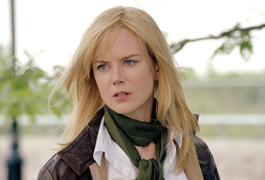home | metro silicon valley index | movies | current reviews | essay

Photograph by Phil Bray
To Die For: David Thomson finds Kidman gold even in dross like 'The Interpreter.'
Mash Note To Nicole
David Thomson's new study of Nicole Kidman falls in love with the image, not the woman
By Richard von Busack
THOSE unaware of David Thomson can imagine the critic as Ian McKellen in The Da Vinci Code: a heresiarch in the temple of film studies, a professor of forbidden lore and alternative histories; a man never ashamed of the grand gesture or elegant blasphemy. His New Biographical Dictionary of Film cast doubts about the accepted faith: for instance, the too-easiness of being Cary Grant, or the importance of being John Ford. And just as McKellen overshadowed the luckless cast of Ron Howard's cinematic smudge-pot, Thomson stands out in relief against the critical pack of buzz artists and daily dogs.
In his critic-battered new book, Nicole Kidman, Thomson returns to his first love. But that love is not the actress of the title. If The New York Times' Lawrence Levi is correct in calling Nicole Kidman "a weird and unseemly mash note," it is the strangest one ever intercepted.
Thomson addresses his mash note to Kidman's image, rather than to the lady herself. Sure, Thomson indulges in erotic speculation—tittle-tattle is always a part of any fan's fancy. But Thomson's obsession is like any other flirtation with a shadow on a screen. First comes love, then gradual dissatisfaction: "I love her so long as I do not have to meet her."
The old first love I mentioned is really the love Thomson has for the writer Laurence Sterne. Nicole Kidman is a celebrity bio as if written by Tristram Shandy. It discourses; it is discursive. Thomson considers the history of Australia and the vagaries of fame. He imagines a sex life he can only guess at, and he hints at his own waning faith in movies.
Is this a love letter? At one point: "She still sounds like a teenager," he writes. He asks if Kidman could be considered spoiled, since she grew up the daughter of a celebrity doctor.
He is a little incredulous at the men in the actress's life—especially her marriage to the unimaginative Tom Cruise. If the author seems like a man reduced to a fanboy by this pale popcorn Venus, he hasn't lost his speculativeness. He wonders how she will avoid the fate of the actress who has children and loses concentration because "of interest in someone other than herself." He is not condemning selfishness. He is understanding the unwavering focus an artist must have. Many a male star has lost his concentration, even without the excuse that the children come first.
Nicole Kidman sometimes tacks to the windy side of parody. It stirs up scandal; the passages about Kidman's miscarriage or abortion might have been skipped until some larger portion of the truth comes out. But Thomson's appraising thoughts about Kidman's nude scenes count as critiques of her image, seen as a work of art. Imaging films that Kidman might have made is also fair game: Thomson proposes that if there's such a thing as a director's cut, there deserves to be a viewer's cut.
And in excerpting a treacly flirtatious interview by Stephen Rebello, where the writer offers to play Elvis to Nicole Kidman's Ann- Margret, Thomson shows the kind of mash note that he isn't writing. Nicole Kidman only masquerades as supermarket reading.
I would challenge Thomson on his interpretation of Dead Calm—he implies reluctant consent in the sex scene between Kidman's character and Billy Zane's intruder. What I remember, though I'm certainly not going back for seconds, was a nigh- impossible-to-watch rape sequence. (Speaking of the actor's persona, and not of the actor himself, it's hard to imagine that there is such a thing as consensual sex with Billy Zane.)
In other matters, Thomson is correct: the fiasco of the San Francisco critics' screening of Eyes Wide Shut took place just as he records it. "Everyone wants to see Eyes Wide Shut; until they see it." Thomson lays the failure on Kubrick's uncertainty, as well as on the fruitless effort to turn Cruise from a movie star into an actor. His "viewer's cut" of Eyes Wide Shut is one I'd pay money to see.
Kidman endures rough times now; after wasting her talent on movies like The Stepford Wives and Bewitched, she is back in the tabloids. Her new husband, Keith Urban, entered a rehab clinic. Kidman is backing away from interviews, right when she could be explaining the nuances of her upcoming film, Fur: An Imaginary Portrait of Diane Arbus. (Those who would argue that Kidman's appearance in Bewitched was necessary for career maintenance are going to be flabbergasted by Fur: "Who wants to see Nicole Kidman kissing a sideshow dog-faced boy?")
Thomson's guidance left me a little more open to her new film than I might have been without him. What arouses Kidman most as an actress is the uncanny: that's the source of her moon-woman poise, her level gaze and her voyeur's half-parted mouth. Reacting to new flesh, in Fur, or to a dead bird, in The Hours—and nothing is as dead as a dead bird—Kidman always embraces the strange with a passion few goths could match.
It is Kidman's mainstream movies that drive me away, as when she was an overexposed Xerox of Marilyn in Moulin Rouge!. Kidman's very whiteness can make her fade onscreen, and she can be a sphinx without a riddle. When Thomson imagines her as Catherine Deneuve in Belle de Jour, I finally understood: Kidman is the ultimate postmodern actress, a leading lady for an age when movies are not made, but remade.
![]() Nicole Kidman, by David Thomson;
Knopf; 284 pages; $24.95 cloth
Nicole Kidman, by David Thomson;
Knopf; 284 pages; $24.95 cloth
Send a letter to the editor about this story.
|
|
|
|
|
|